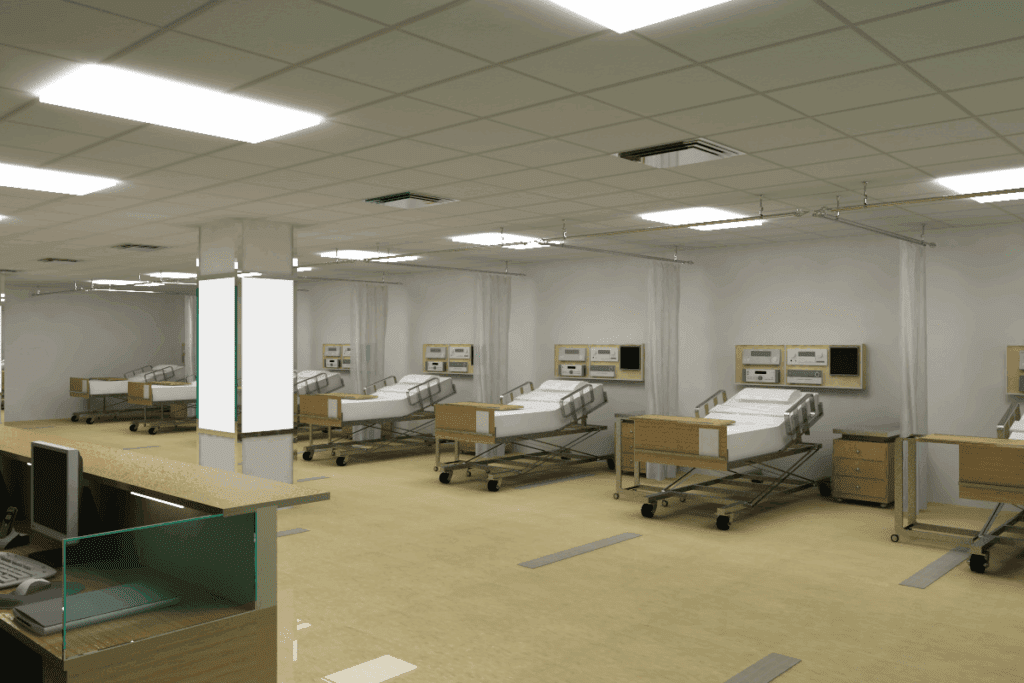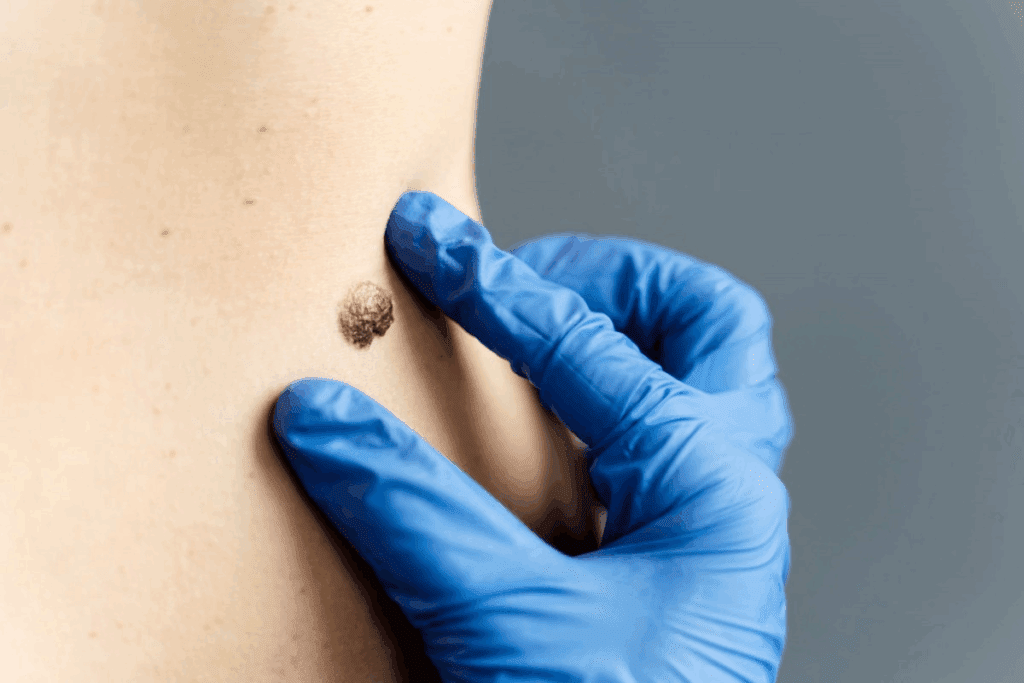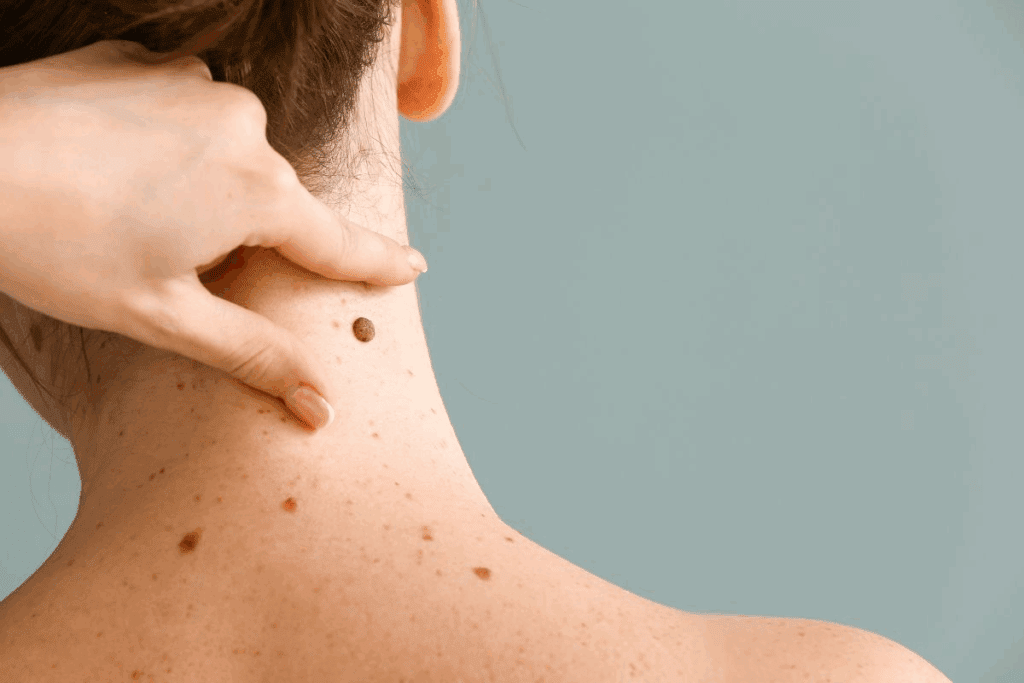Last Updated on October 31, 2025 by Saadet Demir

Skin cancer is the most prevalent malignancy in the United States. About 5.4 million basal and squamous cell skin cancers are diagnosed every year. Knowing how to spot dangerous lesions early is key to saving lives.
Identifying suspicious spots is the first step in fighting this common cancer. Our guide shows you the different types of skin cancer and what they look like. This helps you take charge of your health.
At Liv Hospital, we aim to provide top-notch healthcare for international patients. Our focus is on you, with medical skills that ensure accurate and effective skin cancer treatment.

Skin cancer is a big deal in the U.S. It’s important to know about it to prevent and treat it. Our skin protects us from harm, but too much sun can change normal cells into cancer.
Skin cancer is the most common cancer in the U.S. Every day, over 9,500 people get diagnosed. Basal cell carcinoma is the most common type, showing up as persistent lesions on sun-exposed areas. Each year, more than 5.4 million cases of basal cell and squamous cell skin cancers are found in the U.S.
There are several things that can increase your risk of getting skin cancer. These include:
Knowing these risk factors can help you take steps to lower your risk of getting skin cancer.
Finding skin cancer early is key to better treatment. Early detection means a higher chance of successful treatment. This can lower the risk of complications and improve survival rates. Regular self-exams and professional skin checks are vital for catching suspicious spots early.
It’s important to know the signs and symptoms of skin cancer. If you notice anything unusual, get medical help right away.

The ABCDE method is a well-known way to spot moles that might be cancerous. It helps people find skin spots that need a doctor’s check. This method is key for self-exams.
Asymmetry is the first thing to check when looking at moles. Normal moles are symmetrical, but cancerous ones are not. Imagine a line through the mole. If the halves don’t look the same, it’s a sign to worry.
The mole’s border is also important. Benign moles have smooth edges, but cancerous ones are irregular. If the border is not clear, see a doctor.
Color changes in a mole can mean trouble. Benign moles are usually one color, but cancerous ones have many. Watch for moles with brown, black, or red, white, and blue spots.
The size of a mole is also key. Melanomas are bigger than normal moles. Moles over 6mm (like a pencil eraser) are worth checking.
| Characteristic | Benign Mole | Potentially Cancerous Lesion |
| Asymmetry | Symmetrical | Asymmetrical |
| Border | Smooth, even edges | Irregular, ragged, or blurred edges |
| Color | Uniform color | Multiple colors or uneven color |
| Diameter | Typically small (<6mm) | Often larger (>6mm) |
Using the ABCDE method helps spot suspicious spots. It’s good for self-exams. Knowing these signs can lead to early detection and save lives.
Basal cell carcinoma is the most common skin cancer. Knowing how it looks is key to catching it early. We need to know its different looks and where it often shows up on the body.
Basal cell carcinoma shows up as lasting spots on sun-exposed skin. It can look like pearly or waxy bumps, flat flesh-colored or brown scar-like lesions, or bleeding or scabbing sores that heal and return. Experts say, “The look of basal cell carcinoma can change a lot, so it’s important to watch for any new or changing skin spots.”
“Early detection of basal cell carcinoma significantly improves treatment outcomes, stressing the need to know its different looks.”
Basal cell carcinoma can also be a pink or red patch that feels rough, or a firm, shiny bump. These different looks mean we should check our skin carefully if we see anything odd.
Basal cell carcinoma often pops up on sun-exposed parts like the face, head, neck, and arms. These spots get more sun, raising the risk of damage and cancer. It’s common for it to show up on the ears, nose, and forehead, where sun exposure is high.
Looking at pictures of basal cell carcinoma can show how it changes and looks different. As it grows, it can get bigger, change color, and feel different. Regular self-exams and skin checks by doctors are key to spotting these changes early. Catching it early means it’s easier to treat.
Knowing how basal cell carcinoma looks and where it shows up helps us spot it early. This way, we can get medical help fast.
Squamous cell carcinoma is a common skin cancer. It can be identified by its unique visual features and textures. This cancer often shows up on sun-exposed areas like the ears, face, neck, and hands.
This type of skin cancer has a rough texture and scaly look. It’s caused by dead skin cells building up. It can look like red or pink lesions that might hurt when touched.
In some cases, it forms a firm, hard nodule or an open sore that won’t heal.
Visual Characteristics:
Squamous cell carcinoma often shows up on sun-exposed areas. Common places include:
These areas get more sun, making them more likely to get this cancer.
Both squamous cell carcinoma and basal cell carcinoma are skin cancers. But they look different. Basal cell carcinoma looks like a shiny, pearly bump or a flat, flesh-colored lesion with a depressed center.
Squamous cell carcinoma, on the other hand, is scaly and rough.
| Characteristics | Squamous Cell Carcinoma | Basal Cell Carcinoma |
| Appearance | Scaly, rough, red or pink | Shiny, pearly, flesh-colored |
| Texture | Rough, may be tender | Smooth, shiny |
| Common Locations | Sun-exposed areas like ears, face, neck, hands | Face, ears, neck, and other sun-exposed areas |
Knowing these differences helps doctors diagnose and treat it correctly.
Melanoma is a serious skin cancer, though it’s rare. It causes most skin cancer deaths. Melanoma often looks like new moles or changes in old ones. It has irregular shapes, multiple colors, and grows in size.
Melanoma has an irregular shape, multiple colors, and evolving size. These traits set it apart from harmless moles. Watch for any new or changing moles, as they can be dangerous.
The ABCDE rule helps spot dangerous moles. Look for Asymmetry, Border irregularity, Color variation, Diameter increase, and Evolving. This rule can guide us in identifying risky moles.
There are different types of melanoma, each with its own look. Superficial spreading melanoma looks like a flat patch or plaque. Nodular melanoma is a raised nodule.
| Type of Melanoma | Appearance |
| Superficial Spreading Melanoma | Flat patch or plaque, often with color variation |
| Nodular Melanoma | Raised nodule, potentially bleeding or ulcerated |
| Lentigo Maligna Melanoma | Slow-growing, flat, and darkly pigmented |
Telling moles from melanoma can be hard. Look for size, color, or shape changes, and symptoms like itching or bleeding. If unsure, see a dermatologist.
Knowing how to spot melanoma and its differences from moles helps us catch it early. This can lead to better treatment outcomes.
Finding skin cancer on the face and head early is key for good treatment and less scarring. These areas get a lot of sun, making them more likely to get damaged and develop cancer.
Skin cancer on the face can show up in different ways, based on the type and where it is. Basal cell carcinoma often looks like a small, shiny bump or a pink patch. Squamous cell carcinoma might look like a firm, red nodule or a scaly patch. Knowing these looks helps spot skin cancers early.
The face is also at risk for melanoma, which is more serious. Melanoma can look like a new or changing mole, often with odd shapes or colors.
The scalp is another area at high risk for skin cancer because of sun exposure. Lesions here can be tricky to spot until they get big. Watch for new or changing growths, like sores that don’t heal, red or pink patches, or nodules. Regular self-checks and visits to the dermatologist are important for catching it early.
Visual aids are very helpful in seeing what skin cancer looks like on the face and head.
Being careful about skin changes on the face and head, and knowing the signs of skin cancer, can help a lot. Regular checks and visits to the doctor are essential for catching and treating skin cancer in these areas.
Skin cancer isn’t just about the face and neck. It can also show up on arms, hands, and fingers. Knowing how it looks on different parts of the body is key to catching it early.
Skin cancer on arms, hands, and fingers can look different. Squamous cell carcinoma often shows up on sun-exposed spots like the backs of hands and fingers. It might look like a firm, rough, or scaly patch, or a sore that won’t heal.
On arms, it could be a new or changing mole, or an unusual growth. It’s important to keep an eye out for any new or changing spots, mainly in sun-exposed areas.
Skin cancer on fingers can be tricky to spot. It’s easy to miss or think it’s something else. But, any lasting or odd change needs a doctor’s check.
Subungual melanoma, a serious melanoma under the nail, is a big worry. It looks like a dark streak or spot under the nail. It’s often caught late, which makes it harder to treat.
Knowing the visual signs of skin cancer on arms, hands, and fingers is vital. Look out for:
Regular self-checks and knowing these signs can help a lot. If you see anything odd, see a doctor right away.
It’s important to know about skin cancer on the torso. This includes the back, chest, and stomach. These areas are often missed during self-checks. The torso is a common spot for skin cancer, often due to sun exposure. But, it can also happen in areas that don’t get much sun.
Skin cancer on the torso can look different, depending on the type. Melanoma can show up anywhere, including the trunk. Knowing what to look for is key to spotting suspicious spots early.
The torso is home to basal cell carcinoma, squamous cell carcinoma, and melanoma. Each has its own look, making it easier to spot them.
Finding skin cancer on the torso can be tough, like spotting it on the back. Regular self-checks with a mirror or help from someone else are helpful. Look for new or changing moles and any odd skin changes.
Visual aids are great for learning what skin cancer looks like on the torso. Below, we have a table that shows the main features of different skin cancers on the back, chest, and stomach.
| Type of Skin Cancer | Common Characteristics | Typical Locations on Torso |
| Basal Cell Carcinoma | Pearly or shiny bumps, sometimes with visible blood vessels | Chest, back |
| Squamous Cell Carcinoma | Firm, red nodules or scaly, crusted lesions | Back, chest, stomach |
| Melanoma | Asymmetrical moles with irregular borders and varied colors | Anywhere on the torso, including back and chest |
Knowing these signs and checking your skin often can help catch skin cancer early. This can lead to better treatment outcomes.
There are many rare types of skin cancer that people should know about. These cancers can be dangerous and need to be recognized early. It’s important to understand what they look like.
Merkel cell carcinoma is a rare and aggressive skin cancer. It starts in Merkel cells in the skin’s top layer. It looks like a firm, painless bump, often on sun-exposed areas like the face and neck.
It’s vital to catch it early. Merkel cell carcinoma can grow fast and spread to other parts of the body.
Dermatofibrosarcoma protuberans (DFSP) is a rare skin cancer that grows slowly. It looks like a firm, painless nodule or plaque, usually on the trunk or limbs. DFSP can grow into surrounding tissues if not treated, but it rarely spreads.
Sebaceous carcinoma is a rare and aggressive cancer. It starts in the sebaceous glands, mainly on the face. It looks like a painless nodule or lump, often mistaken for a chalazion.
Sebaceous carcinoma is very malignant and needs quick treatment.
The following table summarizes the key characteristics of these less common skin cancers:
| Type of Skin Cancer | Typical Appearance | Common Locations | Aggressiveness |
| Merkel Cell Carcinoma | Firm, painless nodule or bump | Sun-exposed areas (face, neck, arms) | Highly aggressive |
| Dermatofibrosarcoma Protuberans | Firm, painless nodule or plaque | Trunk or limbs | Locally aggressive, rare metastasis |
| Sebaceous Carcinoma | Painless nodule or lump | Face, specially around the eyes | Highly malignant |
Knowing about these rare skin cancers is key for early detection and treatment. If you see any unusual skin changes, see a doctor right away.
There are many non-cancerous skin conditions that look like skin cancer. Knowing about these can help reduce worry. It also makes sure any real skin problems get treated fast.
Seborrheic keratosis is a harmless skin growth. It looks like a brown, black, or tan lesion. People often think it’s a wart or mole because of its look. These growths are common and can pop up anywhere on the body.
Even though it’s usually harmless, see a dermatologist if it changes. This is important.
Dermatofibromas are small, firm bumps on the skin. They are usually painless and can be brown, red, or purple. They might look like melanoma, but they’re not. These bumps are benign and often show up on the legs.
The exact reason for dermatofibromas isn’t known. But they might be linked to minor injuries, like insect bites.
Cherry angiomas are small, bright red spots. They usually appear on people over 30. These spots are made of blood vessels and are harmless.
| Condition | Appearance | Common Locations |
| Seborrheic Keratosis | Brown, black, or tan lesions | Anywhere on the body |
| Dermatofibromas | Small, firm bumps | Often on the legs |
| Cherry Angiomas | Small, bright red spots | Anywhere on the body |
Even though these conditions are usually harmless, see a dermatologist if your skin changes. The American Academy of Dermatology says, “Early detection is key to treating skin cancer effectively.”
“The best way to ensure you’re dealing with a benign condition is to have any new or changing skin lesions checked by a professional.”
Regular skin checks and knowing about both cancerous and non-cancerous conditions help spot problems early.
Knowing the signs of skin cancer is key to better treatment. Catching it early is vital. Being aware of these signs is the first step to protect your skin.
Certain symptoms need quick medical help. These include:
If you see any of these signs, see a doctor right away.
A dermatologist will check your skin for any odd spots during an exam. This usually involves:
Regular doctor visits and monthly self-checks are the best way to watch for skin cancer.
To keep an eye on your skin, follow these tips:
Being proactive and careful about your skin can help catch skin cancer early. This can lead to better treatment outcomes.
Early detection is key to beating skin cancer. When caught early, treatment works much better. This guide has shown you how to spot skin cancer and why it’s important.
Learning the ABCDE method helps you check your skin. Knowing what to look for can save lives. Regular checks and visits to the dermatologist are essential.
Stay alert to your skin’s health. Teach others about the signs and risks of skin cancer. Together, we can fight skin cancer and save lives through early detection.
Look for new or changing spots, moles, or growths on your arms and hands. Check for spots that are not symmetrical, have irregular borders, or are more than one color. Also, be careful of spots that itch, bleed, or don’t heal.
Melanoma on the scalp can look like a new or changing mole, a sore that doesn’t heal, or a spot that bleeds. It might be hidden under hair, so it’s important to check your scalp regularly for early signs.
Yes, there are several types, including basal cell carcinoma, squamous cell carcinoma, and melanoma. Each type looks different, with unique appearances, textures, and places on the body where they usually show up.
Yes, conditions like seborrheic keratosis, dermatofibromas, and cherry angiomas can look like skin cancer. If you’re unsure about a skin lesion, it’s best to get a healthcare professional’s opinion for a correct diagnosis.
Do a self-examination every month, checking all parts of your body, even the hard-to-see ones. Keep an eye out for any new or changing spots. If you notice anything unusual, see a doctor.
The ABCDE method helps identify potentially cancerous moles. Check for Asymmetry, irregular Borders, multiple Colors, large Diameter, and Evolving shape or size. Use this method when you’re checking your skin.
See a doctor if you notice a new or changing spot, a sore that doesn’t heal, or any other unusual skin change. Be extra careful if you have a history of skin cancer or get a lot of sun.
A healthcare professional will examine your skin, looking for suspicious lesions and checking your overall skin health. They might do a biopsy if they find anything unusual.
Yes, catching skin cancer early can greatly improve treatment outcomes. Regular self-examinations and professional screenings are key to finding skin cancer early.
National Center for Biotechnology Information. (2025). What Does Skin Cancer Look Like A Visual. Retrieved from https://pmc.ncbi.nlm.nih.gov/articles/PMC11188824/
Subscribe to our e-newsletter to stay informed about the latest innovations in the world of health and exclusive offers!
WhatsApp us